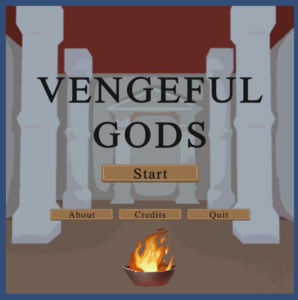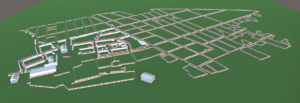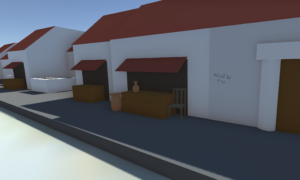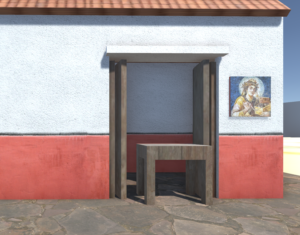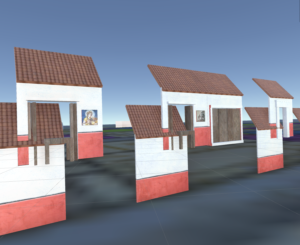Last week was all about approximating humans.
Monday was roughly my experimentation with Albinus. 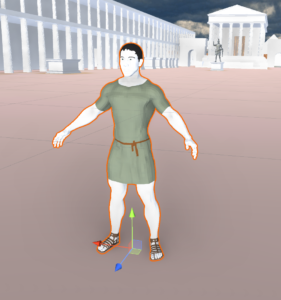 I named him that because he was a porcelain-white 3D base model I found and used essentially as a dressmaker’s dummy while I developed my skills in making 3D clothing and texturing. I modeled tunica et calcei (a tunic and shoes), then gave him some bones and animated him. Oh, and gave him hair and eyeballs. My first Pompeiian citizen, except that I hadn’t made the model and he was a color that would make plain marble look tan. Next, I decided to whip up a UV atlas. If you’re not familiar, that’s basically like a single image that encompasses your color palette and can be used to add those colors to everything rather than having to make separate materials for every color on every object. It’s an efficiency thing. That sent me down rabbit hole after rabbit hole. What pigments did they use in Pompeii murals? What colors of dye could be made with plants native to the region? What were the most common metals?
I named him that because he was a porcelain-white 3D base model I found and used essentially as a dressmaker’s dummy while I developed my skills in making 3D clothing and texturing. I modeled tunica et calcei (a tunic and shoes), then gave him some bones and animated him. Oh, and gave him hair and eyeballs. My first Pompeiian citizen, except that I hadn’t made the model and he was a color that would make plain marble look tan. Next, I decided to whip up a UV atlas. If you’re not familiar, that’s basically like a single image that encompasses your color palette and can be used to add those colors to everything rather than having to make separate materials for every color on every object. It’s an efficiency thing. That sent me down rabbit hole after rabbit hole. What pigments did they use in Pompeii murals? What colors of dye could be made with plants native to the region? What were the most common metals?
But perhaps the most important question that came up in thinking about color was approximating the skin colors that would be seen in the forum. The light end of the skin color spectrum would be present because the Romans had conquered all the way into Britain and there was significant trade and warfare with Germanic tribes. That meant pale, light-skinned enslaved people, merchants, and craftspeople. But they also had reached Aethiopia, and in fact aethiopicus might be used to refer to someone with the darkest end of the human skin tone spectrum (they had lots of words to describe dark skin, so clearly it wasn’t an uncommon sight). And as one author I found put it, the Mediterranean was “a highway, not a barrier” and travel back and forth to Africa was very common.
Of course, there’s also the fact that the Mediterranean is known for being kinda sunny, and that darkens skin…but on the other hand, beauty standards favored lighter skin enough that wealthy women applied what essentially amounted to lead paint to their skin in order to lighten it–especially wealthy women. So that’s the historical accuracy part.
The flip side is that I’m making a game that will be played by exactly zero ancient Romans, but (hopefully many) modern Americans who have inherited a cultural picture of the time illustrated primarily by unpainted marble statues. Associating wealth and power with lighter skin might be slightly more accurate historically, but not for the reasons my players would unconsciously assume. The average game player will see a light-skinned person and think, “Oh, that person is white,” not “Oh, that person is slathered in lead.” And that’s super problematic because “white” as a racial group didn’t exist then. Without going into it too much, the Romans basically categorized people not by skin color but by place of origin.
I’m still working on how I’ll do that part of the color selection and do it responsibly, respectfully, and anti-racist…ly. 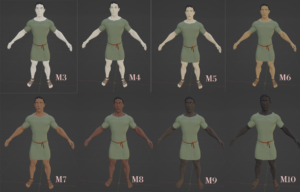 I was referred to a couple of web pages that have some great resources about the intersection of what we know of the ancient world, ideas of “race” or other categorizing of humans, the modern world and what ideas it has received about the ancient world, and so forth. The first was “Who Were the Romans, Part IV: The Color of Purple” by Bret Devereaux. The other was Rebecca Kennedy’s “Race/Ethnicity Bibliography” which as so many references I’m going to be reading forever, give or take. There is so much nuance, but video games are essentially an exercise in oversimplification, so doing it well is going to be a challenge.
I was referred to a couple of web pages that have some great resources about the intersection of what we know of the ancient world, ideas of “race” or other categorizing of humans, the modern world and what ideas it has received about the ancient world, and so forth. The first was “Who Were the Romans, Part IV: The Color of Purple” by Bret Devereaux. The other was Rebecca Kennedy’s “Race/Ethnicity Bibliography” which as so many references I’m going to be reading forever, give or take. There is so much nuance, but video games are essentially an exercise in oversimplification, so doing it well is going to be a challenge.
I learned about the Monk Skin Tone Scale, developed in part to reflect a broader range of human skin colors than the older but widely referenced Fitzpatrick scale, which was mainly developed to study tanning of light skin. I think I’m going to have the typical NPC be darker than the center of the range, but still represent most of the range. The colors will definitely be randomized so both enslaved people and those with power and wealth can be of any skin color.
Anyway, all that to say I’ve got a draft of hopefully somewhat accurate Pompeiian colors.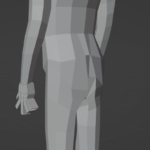
Finally, I’d noted that the base model I used for Albinus was, well, kinda jacked. I described him to my cousin as having a physique that made Henry Cavill look kinda skinny. Because of this, I thought I’d I’d work on my own 3D human character model–my first! What I learned doing that is first that I’m starting to get comfortable with the basic Blender commands, and second, that I apparently have never seen human buttocks in my entire life. I kept thinking, “Surely that’s not what a butt looks like, is it? I don’t even know any more.”
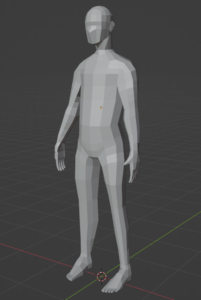 I tried a second 3D model using a different reference image, and it worked much better. Part of that is no doubt experience, but I also think it’s because the second reference image was a synthetic human, a digital model of some sort, not a photograph of an actual one who might have a slightly different posture in side view than front view. Weirdly, though, even the reference photos of the digital model had nipples that didn’t line up between the two pictures. (When I mentioned this to my best friend, he assured me not to worry as this is entirely normal. I had to explain to him that no, I meant the model’s left nipple was at a different elevation from the floor than his left nipple seen from the side.)
I tried a second 3D model using a different reference image, and it worked much better. Part of that is no doubt experience, but I also think it’s because the second reference image was a synthetic human, a digital model of some sort, not a photograph of an actual one who might have a slightly different posture in side view than front view. Weirdly, though, even the reference photos of the digital model had nipples that didn’t line up between the two pictures. (When I mentioned this to my best friend, he assured me not to worry as this is entirely normal. I had to explain to him that no, I meant the model’s left nipple was at a different elevation from the floor than his left nipple seen from the side.)
Giving him bones and an animation and I realized he had webbed arms. Whatever. Work in progress. But at least the second one isn’t, as my best friend called my video test of the first one, “a thing of nightmares.” I call that progress. Progress would also include clothes.

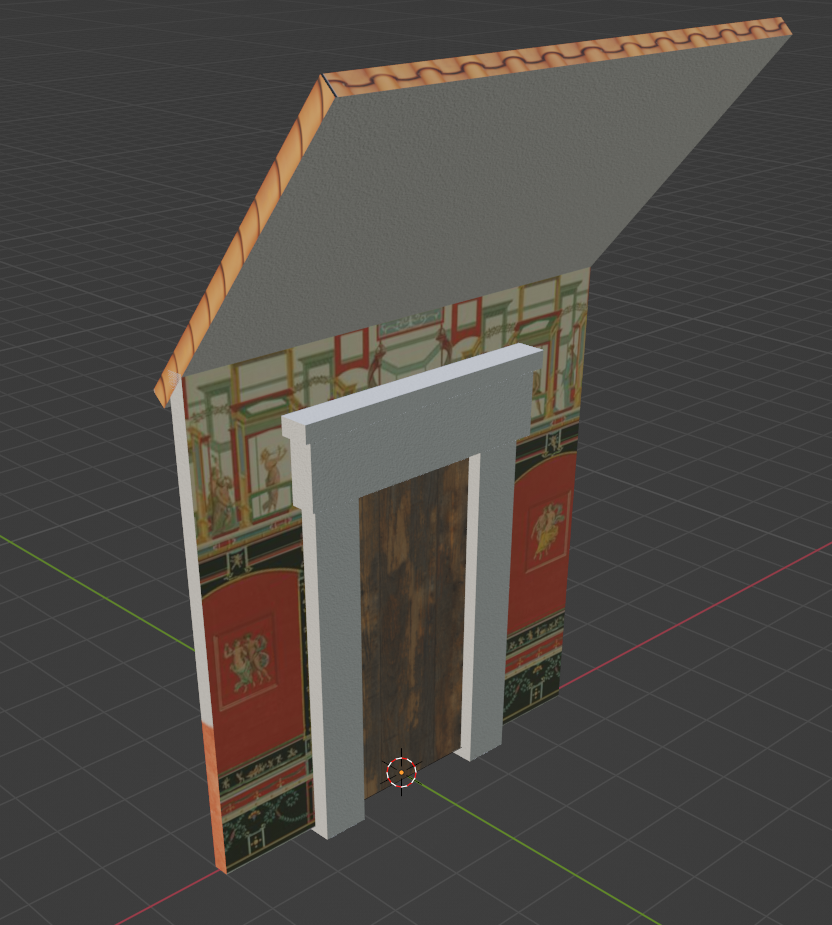 Then I retextured all of my models in Blender. This time, however, I knew how many models I had that essentially used the same textures, and knew more about texturing. First, I went through all the highly common textures and made sure that either I had made them, bought them, or could verify that they were licensed as free to use for commercial projects. (More recent realization: I had been looking specifically for Creative Commons “CC0” license, which is essentially public domain, but I’ve expanded to “CC-BY” which has a lot more options and requires only giving credit, which I usually overdo anyway.)
Then I retextured all of my models in Blender. This time, however, I knew how many models I had that essentially used the same textures, and knew more about texturing. First, I went through all the highly common textures and made sure that either I had made them, bought them, or could verify that they were licensed as free to use for commercial projects. (More recent realization: I had been looking specifically for Creative Commons “CC0” license, which is essentially public domain, but I’ve expanded to “CC-BY” which has a lot more options and requires only giving credit, which I usually overdo anyway.)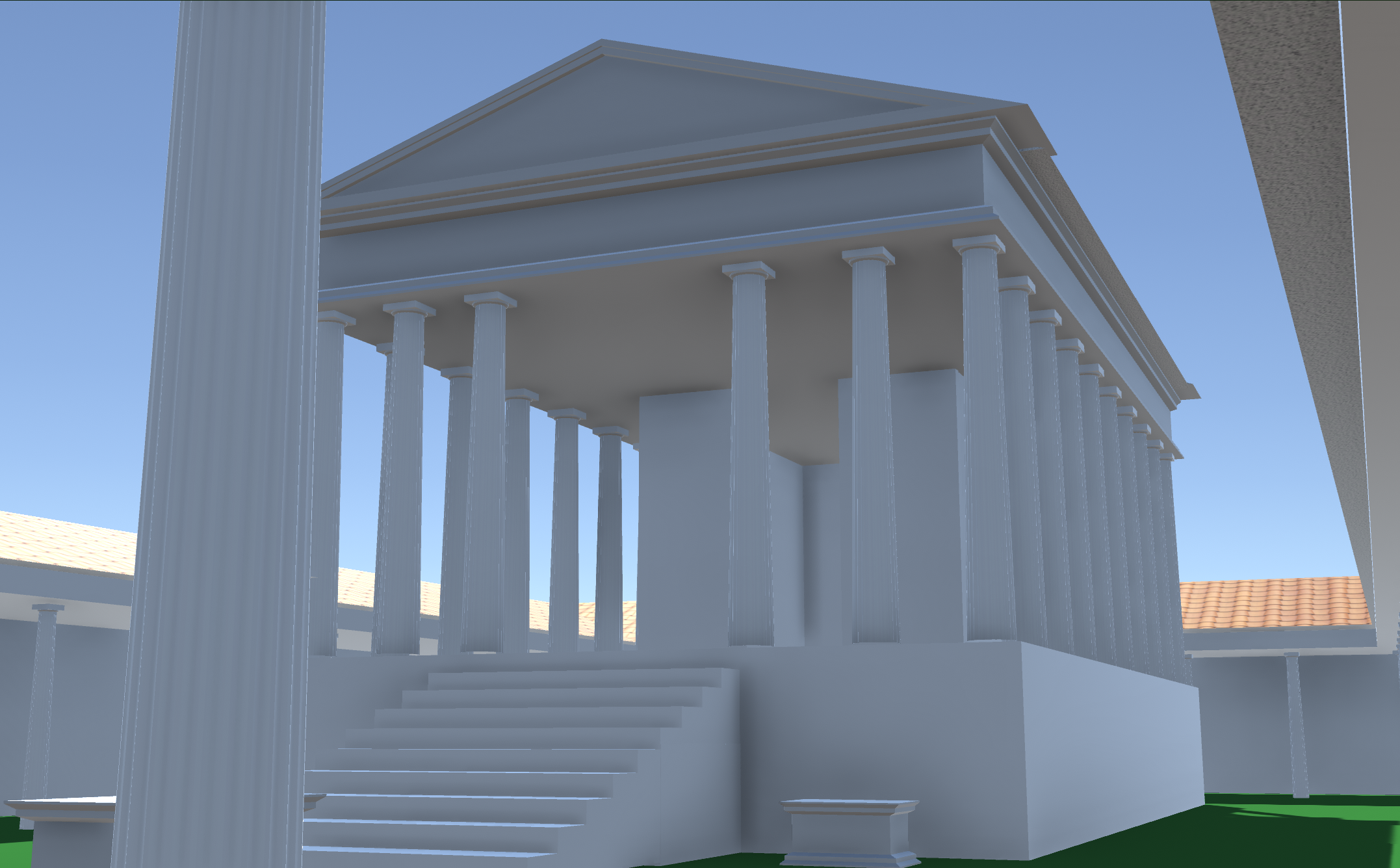 I’d also picked up other Blender tricks in the meantime, and a little
I’d also picked up other Blender tricks in the meantime, and a little 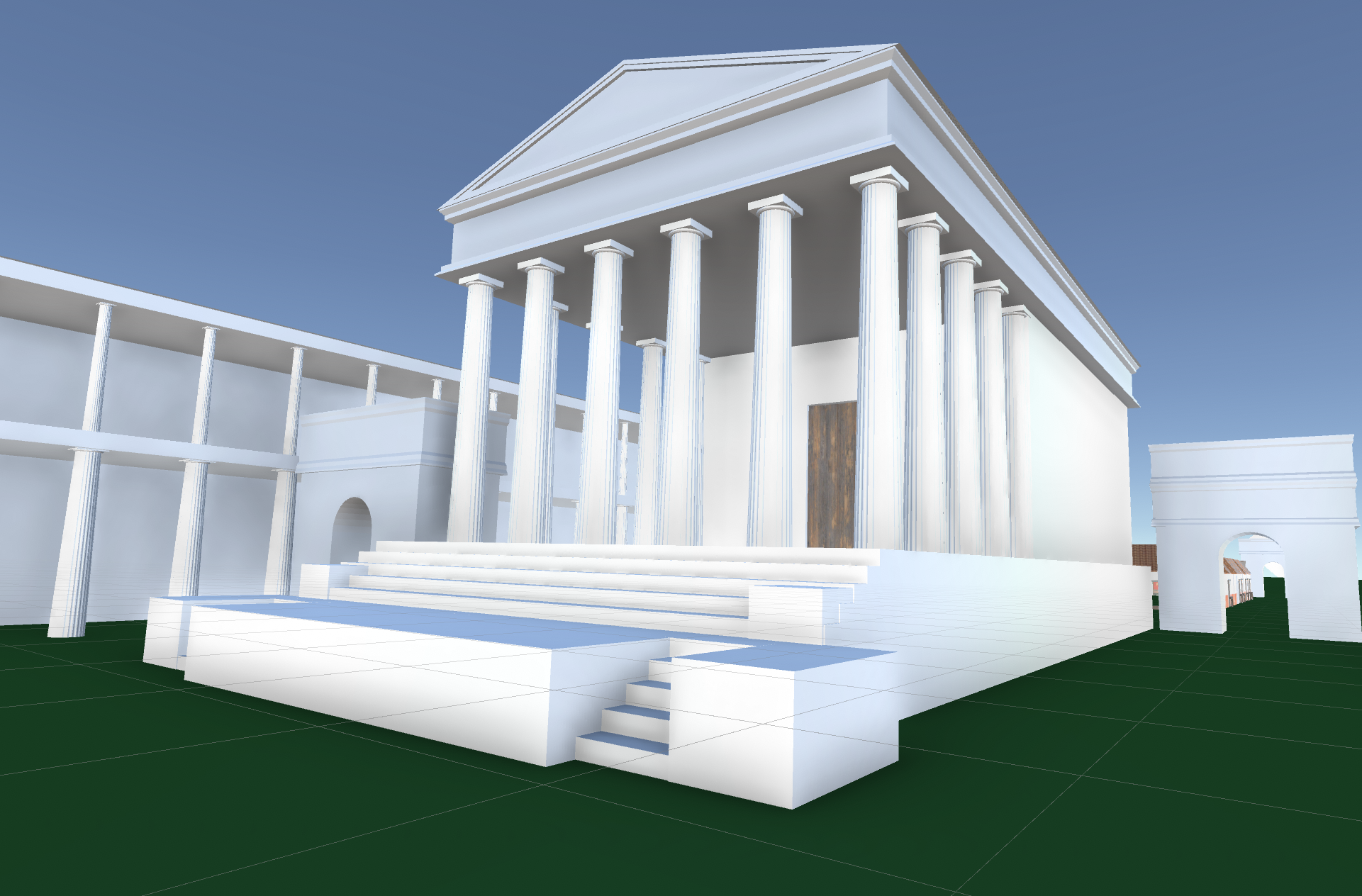 These improvements made rebuilding the Temple of Jupiter and the first run at building the Temple of Apollo (a) faster, (b) more unique and historically accurate than the resized “ancient temple” model I had, and (c) looks much better. I do wish, though, that Unity had a way of making its rectangular prism (“cube”) into something trapezoidal, given that not everything is at 90 degree angles in this city. The entablatures were also useful in adding a little detail to my previous “block with arched doorway” model to be a reasonable approximation of a triumphal arch.
These improvements made rebuilding the Temple of Jupiter and the first run at building the Temple of Apollo (a) faster, (b) more unique and historically accurate than the resized “ancient temple” model I had, and (c) looks much better. I do wish, though, that Unity had a way of making its rectangular prism (“cube”) into something trapezoidal, given that not everything is at 90 degree angles in this city. The entablatures were also useful in adding a little detail to my previous “block with arched doorway” model to be a reasonable approximation of a triumphal arch. 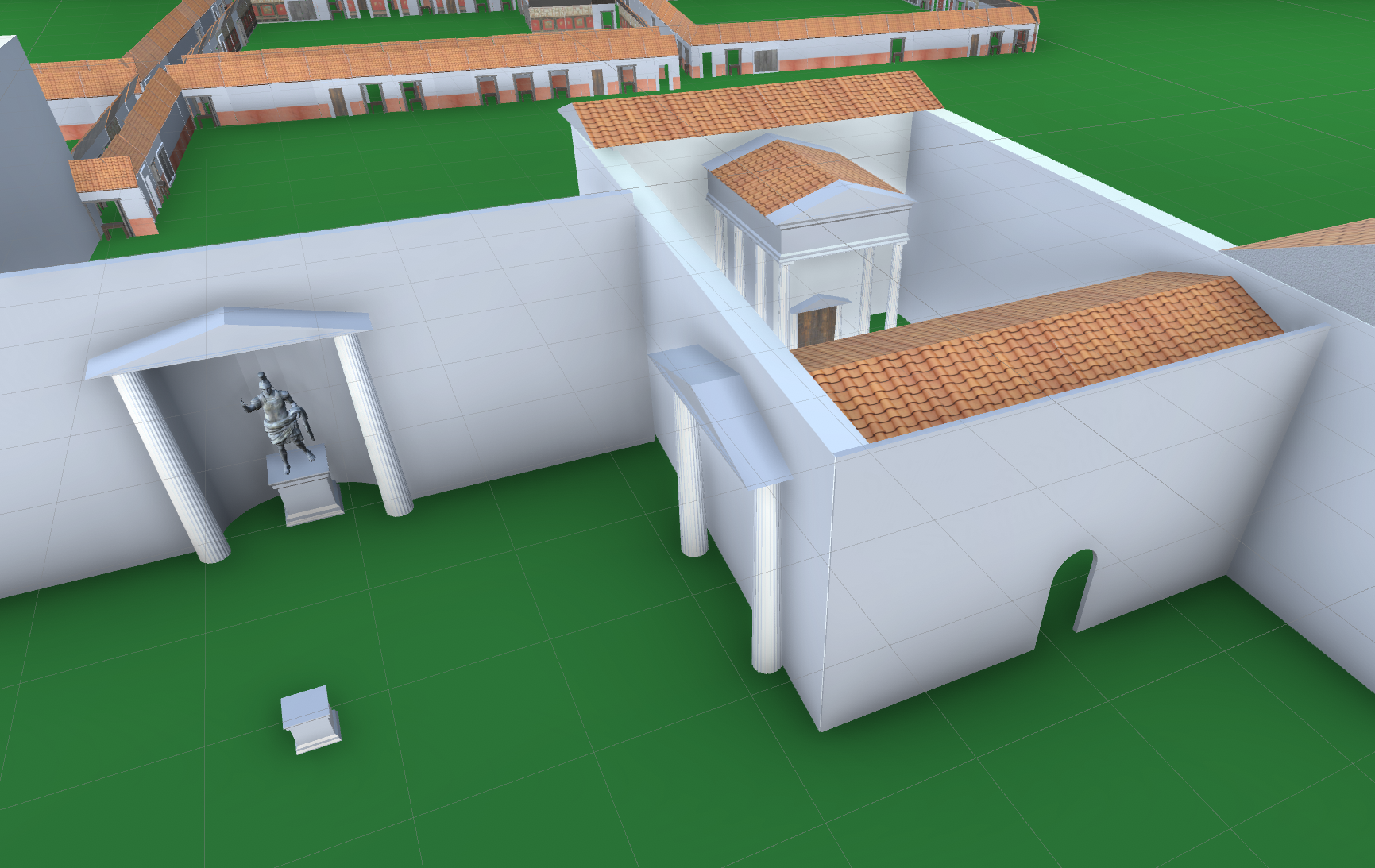 This gave me a taste for making more custom pieces in Blender. For example, the Sanctuary of the Public Lares has a very large half-barrel shaped nook in the back wall, and the Temple of Mercury has kind of a small door in a very large screening wall which doesn’t work well by scaling a regular door piece.
This gave me a taste for making more custom pieces in Blender. For example, the Sanctuary of the Public Lares has a very large half-barrel shaped nook in the back wall, and the Temple of Mercury has kind of a small door in a very large screening wall which doesn’t work well by scaling a regular door piece.